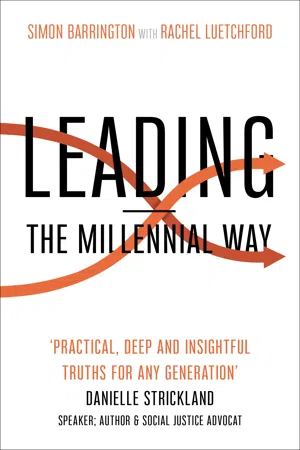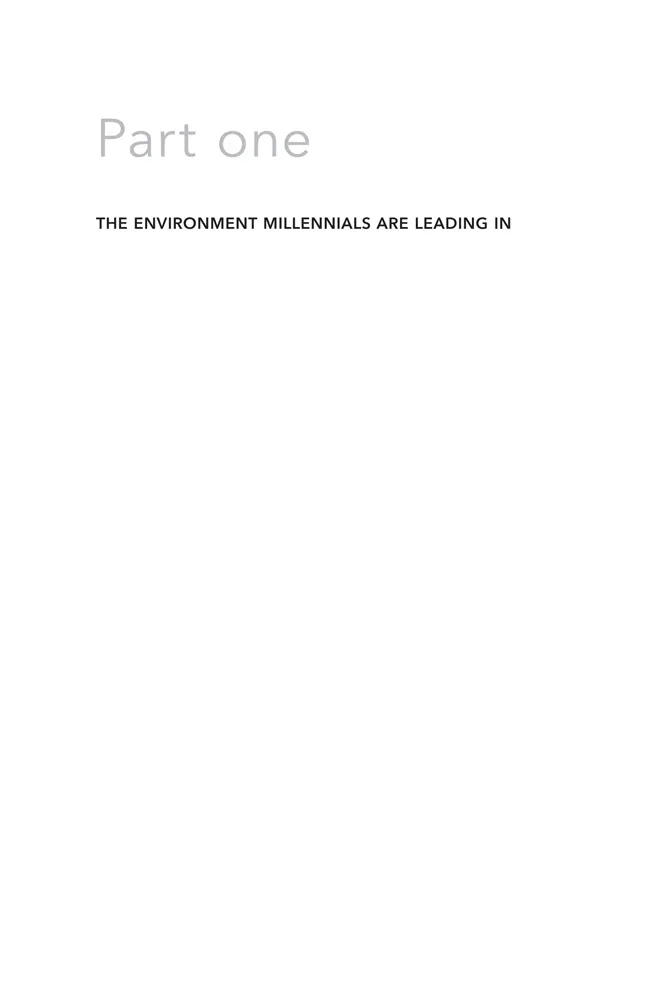![]()
![]()
Chapter one
The ground is shifting
Simon: Aged 21, I woke up in the middle of the night in the midst of a 6.8 magnitude earthquake on the fifth floor of a high-rise building in Taiwan. The tectonic plates had collided and my known world was thrown into immediate chaos as all around me buildings shook. In a similar way, trembling exists in our workplaces. The leadership environments of old and new collide, tension and conflict arising as we all learn to navigate this new terrain. This tension was exemplified when we interviewed millennial leader Jon Gosden.
Jon is 29 years old and has already been in business for over a decade. Beginning his business career while still at school with a web-hosting enterprise run from his bedroom, he scaled it up to more than a hundred clients before he left university. Following this, Jon became a Technology Consultant and then Senior Consultant in a very short period of time. He is currently working for a technology company that specializes in transforming the way organizations utilize technology to use their data.
Jon described to us the environment he works in:
I work for a big tech company that is very flat organizationally, so it means that the best idea always wins and people are fairly collaborative. I don’t respond well to being told what to do and most people I work with don’t either, so it has to be a shared growing vision of how we could do something better. The approaches that work here are being open and transparent with what we are thinking, getting everyone’s views and working together. I spend most of my time, though, working with governments, which tend to be the opposite. They can be very hierarchical, so bringing people with you is much harder. It’s a difficult balance between two very different cultures and trying to bridge that is hard. I’m trying to be more relational and therefore have more influence.
I think that millennials by nature care a lot less about structure and traditional hierarchies and look for much more informal and relational ways of doing things. We also care a little less about traditional roles, titles and status, which means that it’s easier for millennials to lead in the position they are in rather than feeling they have to be anointed to lead. I think that’s often where some of the most innovative work happens.
Over the past generation, we have witnessed dramatic changes in social structures, politics, world views and culture that continue to develop rapidly today. And as Jon’s interview further highlights, the world of work is no exception to these changes.
Frederic Laloux, in his insightful and challenging work, Reinventing Organizations, identifies this shift in organizational structure and culture as a move towards a new level of organizational consciousness. This new way of working recognizes the change in the order of ‘seeking’ in our lives.
Recognition, success, wealth and belonging are no longer the primary things that are sought after. Rather, ‘we pursue a life well-lived, and the consequences might just be recognition, success, wealth and love’.1
Laloux goes on to describe three breakthroughs in organizational structure that he identified in his research, and which categorize the type of organizations that millennials are seeking to lead.
1 Self-management
Learning to operate effectively, even at a large scale, with a system based on peer relationships and without the need for either hierarchy or consensus.
2 Wholeness
Developing a consistent set of practices that invite us to reclaim our inner wholeness and bring all of who we are to work, rather than leaving parts of ourselves at home.
3 Evolutionary purpose
Members of the organization are invited to listen to and understand what the organization, which is regarded as a living organism, wants to become, what purpose it wants to serve and to adapt the organization accordingly.
Rachel: This emerging organizational revolution feels almost intuitive for many of us among the millennial generation. In a survey of nearly 7,700 millennials globally in 2016, Deloitte found 87 per cent of us were saying that ‘the success of a business should be measured in terms of more than just its financial performance’2 and yet 54 per cent believed businesses around the world ‘have no ambition beyond making money’. The issue of purpose in organizational life has become a critical one.
We want to contribute to the positive impact business has on society, but in so doing, we wish to stay true to our personal values. Therefore, we tend to choose organizations whose values reflect our own – a concept reinforced by Deloitte in finding that, globally, 56 per cent of millennials have ‘ruled out ever working for a particular organization because of its values or standard of conduct’, which don’t align with their own.
Simon: Aaron Sachs and Anupam Kundu of Thoughtworks3 have identified five key mind-shifts in the landscape and environment in which millennials are being asked to lead. Whereas Sachs and Kundu identify these as shifts, they are in reality polarities that organizations are seeking to navigate and hold in tension. It is not so much a move from profit to purpose (for example) but the need to hold in tension profit and purpose.
Our world is full of such polarities. You may call them paradoxes, dilemmas or tensions. These are seemingly opposing views or poles, which it is tempting to think that we have to make black and white decisions between. Competent leaders both within and of the millennial generation are increasingly learning to manage these polarities effectively. Such leaders are mastering how to both centralize for coordination and decentralize for responsiveness. They are also learning the difference between solving a problem and managing a tension, a big mistake to get the wrong way round, yet many seeking to regain control in this uncertain environment can too often confuse them. Leading the millennial way is arguably more about learning to manage polarities well rather than quick and definitive problem-solving.
Sachs and Kundu’s five polarities
Here are the five polarities that Sachs and Kundu identify as shifts.
1 Profit and purpose
Organizations are becoming more holistic in their outlook and embracing the need for a balanced view of the sustainable good they are having on society.
2 Hierarchies and wirearchies
Organizations are becoming more networked and collaborative in the search to become more agile and responsive to huge change.
3 Planning and creativity
Organizations are becoming more creative and embracing wider circles of diversity of thinking to create improved outcomes.
4 Gut instinct and experimentation
Organizations are becoming more experimental in their approach, using digital technologies to experiment, fail quickly, learn and adapt.
5 Privacy and transparency
Organizations are becoming more transparent: to their customers, to their employees and to their shareholders.
The Forge Leadership’s additional three polarities
In addition to these polarities, our original research has identified a further three polarities in the workplace environment, which are given here.
1 Flexibility and community
Organizations are becoming more aware of the need to balance the drive for flexible working with the motivational and productivity benefits of building community.
2 Whole-hearted commitment and whole-life flourishing
Organizations are becoming more committed to the whole-life well-being of their employees and are seeking to balance this with the need for whole-hearted commitment in the workplace.
3 Safety and challenge
Organizations are realizing the need to create ‘safe’ spaces in which people feel trusted and that this builds greater levels of productivity and creativity, at the same time as creating environments that are high in challenge.
There are many great organizations that are holding these polarities in bold tension as they seek to navigate the shifting environment they are working in. There are others that are particularly good at one but struggle to navigate the rest.
‘Shaking’ organizations
In Parts two and three, we will look at why our organizations are ‘shaking’ as a result of the collision and contrast between old and new styles of leadership. But, before we do, it’s important to survey the landscape to better unders...

